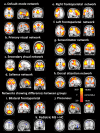Alterations in Functional and Structural Connectivity in Pediatric-Onset Multiple Sclerosis
- PMID: 26731278
- PMCID: PMC4701472
- DOI: 10.1371/journal.pone.0145906
Alterations in Functional and Structural Connectivity in Pediatric-Onset Multiple Sclerosis
Abstract
Background: Reduced white matter (WM) integrity is a fundamental aspect of pediatric multiple sclerosis (MS), though relations to resting-state functional MRI (fMRI) connectivity remain unknown. The objective of this study was to relate diffusion-tensor imaging (DTI) measures of WM microstructural integrity to resting-state network (RSN) functional connectivity in pediatric-onset MS to test the hypothesis that abnormalities in RSN reflects changes in structural integrity.
Methods: This study enrolled 19 patients with pediatric-onset MS (mean age = 19, range 13-24 years, 14 female, mean disease duration = 65 months, mean age of disease onset = 13 years) and 16 age- and sex-matched healthy controls (HC). All subjects underwent 3.0T anatomical and functional MRI which included DTI and resting-state acquisitions. DTI processing was performed using Tract-Based Spatial Statistics (TBSS). RSNs were identified using Independent Components Analysis, and a dual regression technique was used to detect between-group differences in the functional connectivity of RSNs. Correlations were investigated between DTI measures and RSN connectivity.
Results: Lower fractional anisotropy (FA) was observed in the pediatric-onset MS group compared to HC group within the entire WM skeleton, and particularly the corpus callosum, posterior thalamic radiation, corona radiata and sagittal stratum (all p < .01, corrected). Relative to HCs, MS patients showed higher functional connectivity involving the anterior cingulate cortex and right precuneus of the default-mode network, as well as involving the anterior cingulate cortex and left middle frontal gyrus of the frontoparietal network (all p < .005 uncorrected, k≥30 voxels). Higher functional connectivity of the right precuneus within the default-mode network was associated with lower FA of the entire WM skeleton (r = -.525, p = .02), genu of the corpus callosum (r = -.553, p = .014), and left (r = -.467, p = .044) and right (r = -.615, p = .005) sagittal stratum.
Conclusions: Loss of WM microstructural integrity is associated with increased resting-state functional connectivity in pediatric MS, which may reflect a diffuse and potentially compensatory activation early in MS.
Conflict of interest statement
Figures


References
-
- Ghezzi A, Deplano V, Faroni J, Grasso M, Liguori M, Marrosu G, et al. Multiple sclerosis in childhood: clinical features of 149 cases. Mult Scler. 1997;3: 43–6. - PubMed
-
- Mori S, Zhang J. Principles of diffusion tensor imaging and its applications to basic neuroscience research. Neuron. 2006;51(5): 527–39. - PubMed
-
- Le Bihan D, Mangin JF, Poupon C, Clark CA, Pappata S, Molko N, et al. Diffusion tensor imaging: concepts and applications. J Magn Reson Imaging. 2001;13(4): 534–46. - PubMed
Publication types
MeSH terms
LinkOut - more resources
Full Text Sources
Other Literature Sources
Medical

